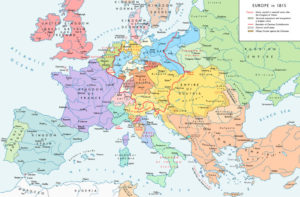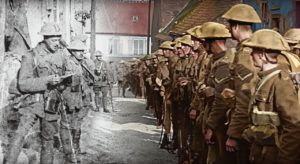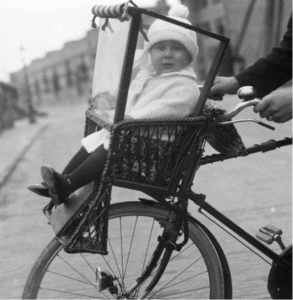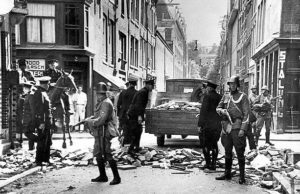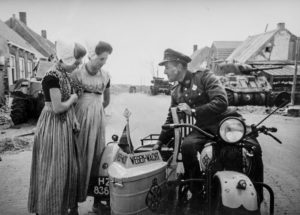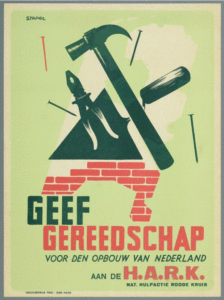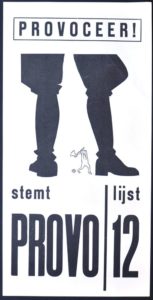Geen producten in je winkelmand.

- Dit event is voorbij.
Course on ‘The “hot” Interbellum and the Miracle of Reconstruction’
04/10/2019 @ 10:00 - 12:30
€255
During this course we will focus on the causes and consequences of the Second World War in The Netherlands.
The Second World War is the most well known war that has ever been waged. That certainly also applies for the Netherlands. Within this horrific period between 1940 and 1945 the Holocaust comes to the fore time and again. Every description of that war is about the Holocaust, about the beginning and the end of the war and about a number of startling developments during that war.
During this course we will take a new approach – we’ll focus on the causes and consequences of the Second World War. Because that infamous war of course does not stand on its own. It is often forgotten to point out the causes of the Second World War, the causes in the long term, but also the causes that immediately precede it. These are the developments of the Interbellum, a period that began exactly one hundred years ago and which is therefore completely “hot” at the moment. The term refers to the period immediately preceding the war and also indirectly refers to the importance of the First World War. Both are important developments in the run-up to the Second World War and that is why we’ll discuss them extensively.
Moreover, the Second World War in the Netherlands leads to a magical development … that of the Reconstruction! After the war, it appears that the macabre situation that existed made way for a more intimate collaboration than we have seen in a long time in the Netherlands. This cooperation leads to a wonderful result: we rebuild our country like it has never been before!
At the end of this course it will ultimately become clear how the causes and consequences of the Second World War determine societal developments in the Netherlands of 2019.
The course:
Lecture 1: Introduction & the long 19th century
Lecture 2: The First World War from 1914 to 1919
Lecture 3: The Interbellum I – Pillarization and modernity from 1919 to 1929
Lecture 4: The Interbellum II – Difficulties from 1929 to 1936
Lecture 5: The Interbellum III – Improvement from 1936 to 1940
Lecture 6: The Second World War from 1940 to 1945
Lecture 7: Reconstruction I – The first recovery from 1945 to 1948
Lecture 8: Reconstruction II – The Roman-Red coalitions from 1948 to 1958
Lecture 9: Reconstruction III – The development of the welfare state from 1958 to 1966
Lecture 10: Reds and conservatives from 1966 to 1989 and the disintegration thereafter
Please book this course at the bottom of the page.
This course consists of ten lectures, which are always given on Friday from 10 A.M. to 12:30 P.M. at the public library (OBA) on the Roelof Hartplein 430. The course starts on Friday 4 October 2019 and ends on Friday 13 December 2019. Due to the October holiday there will be no lecture on Friday 25 October.
With this lecture series you will receive a free digital syllabus.
Please read the detailed explanation per lecture below.
Lecture 1: Introduction & the long 19th century
Historians agree: there is such a thing as a “Long 19th Century”. That century would have started in 1789 with the French Revolution and have ended with the First World War. It is the century of “nationalism” and during that century the European map changes more than drastically. Perhaps most remarkable is the merging of a large collection of small states and statelets, which together form Germany from 1871 onwards.
On this map from 1815 you see the German Confederation in a red line, in many respects the successor of the Holy Roman Empire. This political entity would also form the precondition for the creation of the state of Germany from 1871 on.
Among other things, nationalism leads to three wars between the new state of Germany and the old dominant power on the European mainland that had always been France. The second of those three wars would go down in history as the First World War. In this first lecture we elaborate on the way in which that war changes the world forever and also has a major influence on the Netherlands.
Lecture 2: The First World War from 1914 to 1919
During this lecture we see how at the beginning of the second decade of the twentieth century the Netherlands still seems to be in deep hibernation. When the acclaimed colonial officer Lodewijk Thomson dies in 1914, he is commemorated with a great deal of colonial tribute. Does Tempo Doeloe, the colonial “Good Old Age” also die with him?
Image from the documentary about the First World War by Peter Jackson. He used material from the Imperial War Museum in London
Less than a month later, the First World War breaks out and with it, modern times also dawned in the Netherlands. Our soldiers are still moving around on bicycles and we are lagging behind in many areas. When one of the greatest floods ever occurred in 1916, the necessity for constructing the Enclosure Dam was clear to everyone. At the same time, modern inventions such as the airplane, the telegraph and the tram are developing at lightning speed.
As a direct result of the First World War we get a very modern constitution and when in 1918 the Netherlands is the only country where the German emperor can flee to, he will also find that the old Netherlands no longer exists.
Lecture 3: The Interbellum I – Pillarization and modernity from 1919 to 1929
During the third lecture we see how the ultramodern constitution of 1917, by law, recognizes the existence of subcultures in the Netherlands, and with that the phenomenon of pillarization is entrenched – a development that is conservative in nature and has a restraining character in social terms. A large art of the Dutch christian community is shocked by the advent of modern times and they do their best to defend morality. At the same time, from 1919 to 1929, the Netherlands experienced uninterrupted economic growth for ten years. Even for people with a low income, there is hope for a better future in these years.
A hypermodern development from 1925
What is most striking in these years is the combination of prosperity and modernity. The radio makes its appearance, the cinema and the film are indispensable. We dance to exotic sounds, which have mostly come over from America. 1922 is the year in which women can elect the members of Parliament for the first time.
That does not mean that our ancestors were only optimistic at the time. The happy 1920s always existed in the shadow of the First World War and the fear that this disaster will repeat itself is ever present. Large groups of Dutch people are following an anti-militarist and pacifist course.
Lecture 4: The Interbellum II – Difficulties from 1929 to 1936
In the United States, the 1929 stock market crash is seen as the beginning of The Great Depression. In the fourth lecture we see how depression came more gradually in the Netherlands, somewhere between 1929 and 1931, while the economy experienced a gradual decline over a longer period. In the Netherlands the depression lasted considerably longer than in most other countries, partly due to structural problems of the Dutch economy and mainly due to government policy. The refusal to let go of the Golden Standard, that is to say the link that was deemed safe between the guilder and gold, plays a central role. The Great Depression led to political instability and riots and can in part also be seen as the cause of the establishment of the National Socialist Movement in 1931.
The 1934 Jordan riot – reason for the state to set up a predecessor of the Riot Police
We see the national economic misery in the navy when a mutiny breaks out in the Seven Provinces in 1933 in protest of arrears and in the Jordaan riot of 1934, as a reaction to a reduction in benefits, which was the worst Dutch riot ever. Things get better in the Netherlands at the end of 1936, when the government abandons the Golden Standard. However – there is no real economic stability until after the Second World War.
Lecture 5: The Interbellum III – Improvement from 1936 to 1940
In March 1936, Prime Minister Colijn spoke in soothing words about international politics: “I therefore ask listeners when they later go to their beds to go to sleep as quietly as they do on other nights. There is currently no reason to be really worried.” During this fifth lecture I show how those words gain credibility when the government releases the Golden Standard in September 1936 and the economy improves rapidly. Unemployment is falling and the marriage of Juliana and Bernard in 1937 seems to herald a happier period.
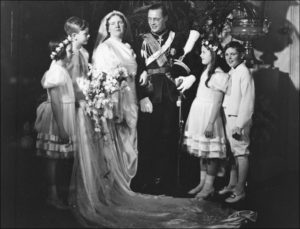
On 7 January 1937, Juliana married Bernhard in The Hague
The construction of the Amsterdamse Bos is being finished. In 1935, the fascist Dutch NSB won 8% of the Dutch vote, but in 1937 their glory had clearly perished: they won only 4% of the vote in the parliamentary elections. In 1938 princess Beatrix is born. International tensions are not that bad, the government wants the Netherlands to believe. The army is being mobilized, but that is only a precautionary measure. Should a conflict break out anywhere, then the Netherlands – in Wilhelmina’s words – will of course “again observe strict neutrality”.
Lecture 6: The Second World War from 1940 to 1945
We look at “the outside” of the Second World War. To what goes on elsewhere, but in particular of course to the Netherlands. How did that war start? What is meant by the dormant “phony war” at the start? What happened between 10 and 14 May 1940? What important role did the Netherlands play in the “Englandspiel”? My – and we’re not there yet … the important question is whether the image that the media created of that war is correct?
Symbol for the continuation of normal life in the Netherlands: the typical Dutch Roadside Assistance in conversation with two young women in traditional costume. In the background the tanks that represent the recent war
And what actually happened in the Dutch East Indies? What about the capitulation of the Netherlands? What economic consequences did the war have? What cultural consequences did the war have? Enough “general questions” that I deal with during the sixth lecture to get a good understanding of the Second World War in the Netherlands.
Lecture 7: Reconstruction I – The first recovery from 1945 to 1948
During the seventh lecture I try to show that not so much the war itself, but rather the misery of the preceding decade was often the biggest motivator to try and recover after the war. The occupation also appeared to have played a unifying role. Remarkably, from 1946 onwards, during the period of Reconstruction, Catholics and Socialists could rule together in the “Roman-Red coalitions.”
The first coalition receives American support in the form of Marshall aid a year later and that same coalition will also make efforts in 1947 to try and overcome Indonesian independence fighters. This happens in the form of so-called “policing actions” and the first of these was carried out between 21 July and 5 August 1947. Partly due to the successful Guided Pay Policy, in an economic sense the Netherlands becomes healthy again during that period.
In 1947, industrial production once again reached the level of 1938. In 1948, the last war damage to buildings and infrastructure had been repaired.
Lecture 8: Reconstruction II – The Roman-Red coalitions from 1948 to 1958
From 1948 on, the Reconstruction enters a new phase. The problems directly related to the occupation have been resolved, but the economy is still not doing too well. The inflation problems that arise do not contribute much to that either. Politically, the cooperation between the Social Democrats and the Catholics continues to work very well. That’s good, because this is also necessary – a number of major challenges arise during this period.
In 1949, for example, we are forced to transfer sovereignty to “our” East Indies. In the same year we see – especially because of the pain that the Occupation has brought – that we can no longer operate independently and that is why we join NATO. Two years later, based on the same consideration, we join the economic cooperation of the European Coal and Steel Community. That is the organization that, after a few detours, will eventually become known as the European Union. In this eighth lecture it becomes clear that the Second World War also caused the Netherlands to work hard for peace and cooperation. One last time, as a direct consequence of the Second World War, we experience a national disaster: the flood disaster of 1953.
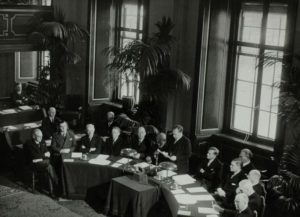
The Drees Cabinet I from 7 Augustus 1948
The third Drees Cabinet (= de facto government), the last of the Roman Catholic-Red coalitions, is from the outset a weak construction that falls apart after some two and a half years. Drees himself will go down in history as the creator of the Dutch welfare state. He set up the General Old Age Law in 1956 and old people will continue to praise him because they “can draw from Drees.”
Lecture 9: Reconstruction III – The development of the welfare state from 1958 to 1966
In this phase we really rise up, while at the same time trauma and prosperity alternate. At the end of the fifties, a gas bubble was found near Slochteren, which was so large that it seemed impossible to ever be able to use it up. This gas bubble would form the basis for the further expansion of the welfare state.
In the ninth lecture we see how the post-war situation of the Kingdom of the Netherlands only becomes clear to the entire nation when we lose Dutch New Guinea in 1962 – it is only then that the Dutchman realizes that he is no longer part of a world empire. We mentally close our minds to the national past and only look to the future. The 1963 Assistance Act also gives the nation a sense of security about that future, and it is already apparent in 1964 how modern we have suddenly become when the progressive program “This is how it happens to be once and again” appears on TV.
When it became clear in the mid-sixties what really happened during the Holocaust, a new awareness arose in the Netherlands. For a group of young rebels, this provides more than enough ammunition when they set up their protest movement “Provo” in 1965. Yes – Provo becomes the face of a young generation emancipating itself with the help of … the Second World War!
Lecture 10: Reds and conservatives from 1966 to 1989 and the disintegration thereafter
In the last lecture we see how the western social revolution also presented itself to us in the mid-sixties. Provo had only just ceased to exist in 1967 only to be followed in 1968 by Joke Smit and Hedy D’Ancona’s Man-Woman-Society. They were part of what is called “the second feminist wave,” a feminist movement of which the Dutch version may have been the most progressive in the world. Social, economic and other ideals of the sixties are made into law under the government of Joop den Uyl between 1973 and 1977.
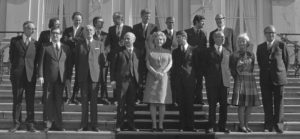
The Reconstruction cooperation knows its climax during that government, but already during that government the first cracks start to become visible in the solidarity of the post-war period. Those cracks become a gap after 1989, the year that the Berlin Wall falls. From that moment on it seems as if “red” and “conservative” keep drifting apart until a polarization appears that cannot be bridged. We find ourselves in that situation today … or is another period of solidarity on the way? Whatever happens; the co-operation of the Reconstruction period seems to have been a time of love and unity, one to which some political parties are keen to return!
This course consists of ten lectures, which are always given on Friday from 10 A.M. to 12:30 P.M. at the public library (OBA) on the Roelof Hartplein 430. The course starts on Friday 4 October 2019 and ends on Friday 13 December 2019. Due to the October holiday there will be no lecture on Friday 25 October.

